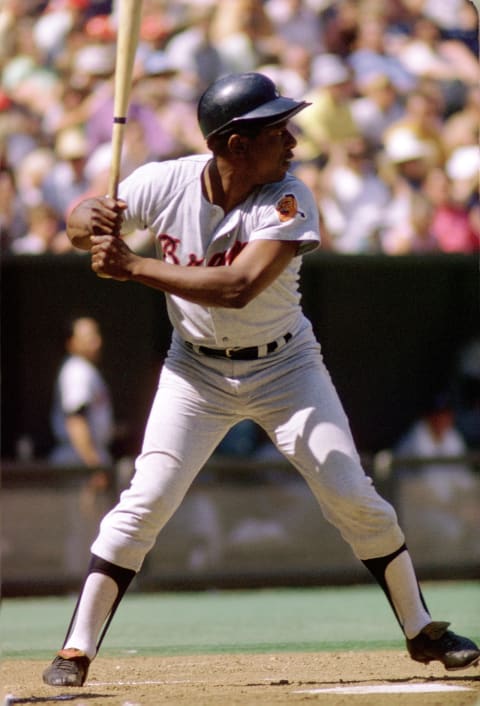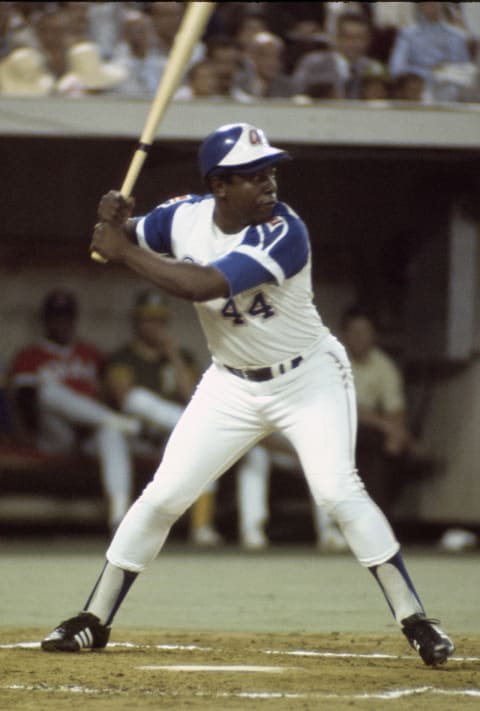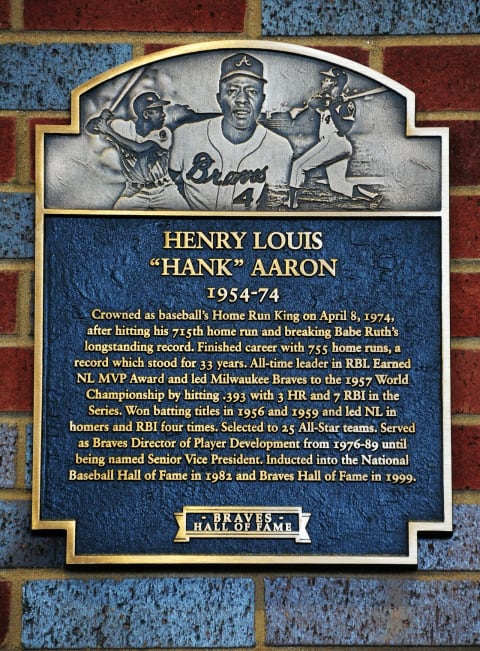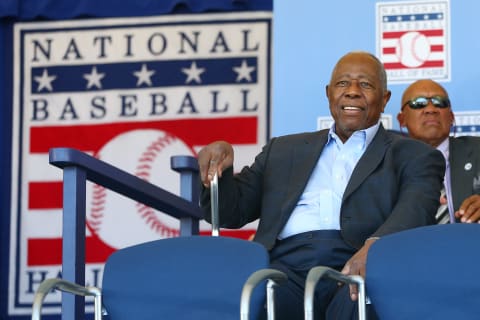Atlanta Braves Franchise all-time top outfielder: Hank Aaron


Atlanta Braves fans know, without any help from me, the name of the franchise’s all-time number one outfielder, but a look back at how he reached that spot is worthwhile.
At the age of 14, future Atlanta Braves legend Hank Aaron began playing semi-pro baseball for the Pritchett Athletics. A year later, Branch Rickey made the mistake of passing up the chance to sign Aaron. No one could blame him for passing at that time. Aaron was a skinny 15-year old shortstop who batted cross-handed.
Later that year, Aaron signed a contract to play for the Mobile Black Bears. His mother agreed to let him sign, but only for home games. Indianapolis Clowns scout Bunny Downs saw him play for Mobile, and in November 1951, signed him to play for Indianapolis at the princely sum of $200 a month.
The Clowns’ were an odd organization. Originally called the Miami Giants, they became the Miami Ethiopian Clowns in 1936, a barnstorming team that arrived at their games in clown makeup, as told by former Clown John Holoway.
We’d come to the park with [grease] paint on our faces like a clown. Even the bat boy had his face painted too. We wore clowning wigs and the big old clown uniforms with ruffled collars. My clowning name was Impo. We’d play ‘shadow ball’…Then when we were supposed to get down to business, we pulled the clown suits off, and we had our regular baseball uniforms underneath. But we didn’t change our faces. We played with the clown paint still on our faces.
In I had a Hammer Aaron said:
(The Clowns) didn’t have the luxury of concerning themselves with something like tradition.”
Their schtick rubbed many of the traditional Negro League teams the wrong way, but they made money. It’s likely Aaron saw the team’s classic antics in much the same way as those newspapers; he refused to take part in the clown acts.
Down in the weeds with Hank Aaron
Statistical records get a bit confusing here. Baseball-Reference tracks both the Clowns and Indianapolis Indians until 1950. After that season, the Clowns don’t appear in their records, although they continued to play for at least three more seasons.
Aaron’s SABR bio – linked above – says he played 26 games at shortstop for the Clowns, batted .366, hit five homers, and stole nine bases to help them to the Negro League World Series. His contribution no doubt helped the Clowns win the first half of the season, but after a road trip, Aaron received offers from the New York Giants and the Boston – now Atlanta – Braves.
On June 14, 1952, Braves paid Indianapolis $10,000 ($99,000 in today’s dollars) and scout Dewey Griggs signed Aaron. The Braves assigned him to C-ball Eau Claire, where he played second base, batted .336, hit nine homers, and was named Northern League Rookie of the Year.
[I]t wasn’t too much of a transition from playing . . .in the Negro League to playing professional baseball,” Aaron told Tavis Smiley of National Public Radio (NPR). “. . . instead of making $400 a month, I was making $600 a month. Instead of getting $2 a day meal money, I was getting $3 a day meal money. So it wasn’t that much of a difference.”
The following season the Braves moved to Milwaukee and Aaron moved to A-ball Jacksonville, where his .362 average, 125 RBI, 115 runs, and 208 hits led the league and earned him another MVP title.
After the 1953 season, Aaron headed to Puerto Rico to play winter ball. It was pretty common for players to play out of position in the winter leagues, and Aaron played his first games as an outfielder there. Coincidentally, his new skill became a shrewd career move.

Bad break = good news for Hank Aaron
The Braves left for Milwaukee with holes in their outfield. They traded Sid Gordon and Sam Jethroe to the Pirates for Danny O’Connell; only Bill Bruton and an aging Andy Pafko remained to man the outfield
To fill one of those slots, they traded four players and cash to the Giants for Bobby Thompson, who promptly broke his ankle in spring training. Aaron had a good spring, took Thompson’s job in the outfield on opening day, and held onto it for 20 years.
His first homer came against the Cardinals, ten days after his Major League debut. Aaron drove in the game’s first run with a single off Vic Rashi in the top of first and hit a solo shot off Rasch in the seventh inning to bring the Braves within one run of the Cardinals. The Braves tied the game and won it in the fourteenth when he followed Pafko home after a Johnny Logan single.
He ended the 1954 season batting .280/.322/.447/.769 with 104 OPS+ and 13 homers, and finished fourth in NL Rookie of the Year voting.
Attention league, Hank Aaron is dangerous
With his first full season under his belt. Aaron began to do the things that made the rest of the league sit up and take notice. As he headed to the first of 24 consecutive All-Star games, he was batting .322/.361/.552/.913 with 17 homers 15 doubles, 56 RBI, and 109 hits.
He cooled slightly in the second half but ended with 27 homers, a league-leading 37 doubles, nine triples, 106 RBI, batting .314/.366/.540/.906, with a 141 OPS plus. and a ninth-place finish in NL MVP Voting.
Over the next 19 seasons Aaron:
- Averaged 36 homers a year, and hit less than 26 only once, 20 in 112 games during the 1974 season
- Averaged 173 hits and total 3280, including 536 doubles and 81 triples
- Drove in 2027 runs, an average of 107 a year
- Walked 1220 times and struck out 1194 – so much for “power hitters must strike out a lot”
- Walked more than he struck out 16 times
- Stole 235 bases in 303 attempts – a 77.5% success rate
- Led the league in …
- Total bases eight times – 1956, 1957, 1959, 1960, 1961, 1963, 1967, 1969
- Homers four times – 1957, 1963, 1966, 1967
- RBI four times – 1957, 1960, 1963, 1966
- Slugging four times – 1959, 1963, 1967, 1971
- Runs three times -1957, 1963, 1967
- OPS and OPS+ three times -1959, 1963, 1971
- Doubles three more times -1956, 1961, 1965
- Average and hits twice – 1956 and 1959
- Sacrifice flies once 1960
- Won
- Three Gold Gloves- 1958, 1959, 1960
- NL MVP in 1957
- finished top ten in MVP voting 11 more times (13 total)
- finished in the top 17 five additional times

Hank Aaron trivia
In 1959 Hammerin’ Hank appeared the Home Run Derby TV show and won six consecutive challenges. This link takes you to his match against future Hall of Fame outfielder Al Kaline. Aaron won of course and twice more before Wally Post eliminated him.
On June 8, 1961, the Braves were getting it handed to them, down 10-2 at the hand of the Reds and Jim Maloney. After Frank Bolling singled to open the top of the seventh:
- Eddie Mathews took Maloney deep into the right-field seats,
- Aaron took Maloney’s next pitch into the left-field seats, cutting the lead 10 five and sending Maloney to the showers in favor of Marshall Bridges,
- Joe Adcock hit Bridges first pitch into the left-field seats, and
- Frank Thomas hit the next pitch to the same place.
Aaron, Mathews, Adcock, and Thomas became to first players to hit back-to-back-to-back-to-back home runs in baseball history
When the league split into divisions, Atlanta Braves ended up in the NL West: they joined three teams Aaron punished annually. He hit 97 of his career homers against the Dodgers, 95 against the Reds, and 78 against the Giants, The Cardinals breathed a sigh of relief because they didn’t see him as often, but The Hammer still fell on the Redbirds 91 times in his 21 National League seasons.
Aaron was the first player to have both 500 homers and 3000 hits, and he is still the only player with more than 3300 hits and 600 homers.
He hit 398 of his 733 Braves homers for the Milwaukee Braves and 335 homers for the Atlanta Braves.
April was a good milestone month for Aaron, He hit homer number 1 on April 23, 1953, number 300 on April 19, 1963, number 400 on April 20, 1966, number 600 on April 27, 1971, number 714 on April 4, 1974, and number 715 on April 8, 1974.
He hit number 100 on August 15, 1957, but the rest of the homer milestones came in July; Number 200 on July 3, 1960, number 500 on July 14, 1968, number 700 on July 21, 1973, and number 755 on July 20, 1975
In his career Aaron homered 385 times at home and 370 on the road; as a Brave, he hit 375 at home and 358 on the road.
The last Atlanta Braves at-bat
On September 11, the Braves game against the Reds in Cincinnati was called after the fifth inning with the score tied 1-1. The Braves lost a doubleheader on September 12 beat the Reds in game 162. After that game:
- The Braves’ were 87-74-1, 14.5 games behind the Dodgers and 4.5 behind the Reds
- The Reds were 98-63-1, 4.5 games behind the Dodgers
- Montreal and the Mets played 181 game seasons after a rainout
Maybe the Braves and Reds played because both teams were there, and had nothing else to do, or needed the gate money from the 11,081 folks who turned up. Whatever the reason, they played the game.
Pete Rose managed one hit towards his eventual record, but Aaron had a better day. He popped up in the first, then walked and scored on a Mike Lum homer in the fourth. In the seventh, Aaron came to the plate for the last time as a member of the Atlanta Braves and promptly launched Rawly Eastwick’s first pitch into the left-field seats. Manager and former teammate Del Crandall replaced him after a curtain call.
In addition to being hit number 3600, it was homer number 733, RBI number 2202, and run number 2107 as a Brave.

Not just a power hitter
When he retired, Aaron’s 624 doubles ranked sixth on the all-time list, today he’s number 13, and the only non-DH in MLB history with 620 or more doubles and 00 or more homers.
Only Ty Cobb and Stan Musial reached 3600 hits in fewer PA that Aaron’s 13090 or games than his 3076 as a Brave.
He reached the 3600 hit mark in his last at-bat of his last game as a member of the Atlanta Braves, and it was game 163 of the season; why they played the game is a mystery.
Aaron ended his career batting .305/.374/.555/.928, a 155 OPS+, 153 wRC+ and a .403 wOBA. In addition to holding the all-time, non-cheaters record for homers with 755, The Hammer also holds baseball’s all-time lead with 6856 total bases and 2297 RBI.
Epilogue
He remains the Atlanta Braves’ best ambassador, and as this quote from Bill Johnson’s biography of Aaron on SABR points out, an American hero.
Hank Aaron not only passed Babe Ruth as Major League Baseball’s career home run leader, but he also made a giant leap in the integration of the game and the nation. Aaron, an African-American, had broken a record set by the immortal Ruth, and not just any record, but the all-time major league home run record, and in doing so moved the game and the nation forward on the journey started by Jackie Robinson in 1947. By 1974 Aaron’s baseball career was within three years of sunset, but the road he’d travelled to arrive at that spring evening in Atlanta had hardened and tempered him, perhaps irrevocably, in ways that only suffering can produce. Aaron finally shrugged off the twin burdens of expectation and fear that evening, and few have ever stood taller.
That’s a wrap
It’s impossible to say something new about one of baseball all-time great all-around players, so I’m not going to try to wax eloquent.
Next. He's number two with a Gold Glove. dark
This wraps up the outfielders; I’ll head back to home plate for the catchers in the next post.